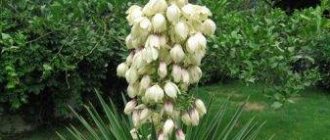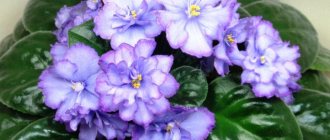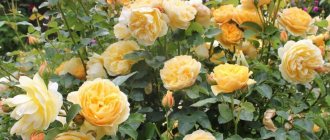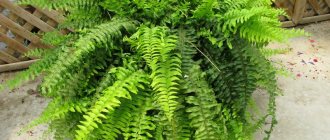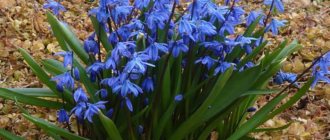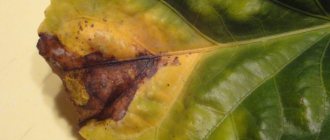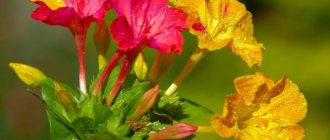The genus of not very large trees and shrubs, Forsythia, or Forsythia, is a representative of the olive family. They bloom in early spring with deep yellow flowers. This genus is considered very ancient, which explains its wide distribution. So, in East Asia you can see 6 different species of this plant at once (in Korea, Japan and China). And in European countries you can find only one species - European forsythia (Forsythia europaea), most of the plants are found in the Balkans. This plant was named after the Scotsman W. Forsythe, who was a botanist, head gardener at Kensington Palace, and also one of the founders of the Royal Horticultural Society. This plant first came from China to European countries thanks to Forsythe.
Description
Let's not change generally accepted traditions - we'll start the review with a description of the external characteristics of the plant. Since forsythia looks very bright and catchy, you will never confuse it with other crops:
Forsythia flowers
- Can be a tree or shrub, length varies from 1 to 3 meters.
- The bark has a rough texture and is colored brownish-gray.
- The leaf blade is oval, simple. Sometimes it is trifoliate. The length depends on the specific type, from 2 to 15 cm.
- Flowers are bright yellow, bell-shaped. You can enjoy lush flowering in just 3 weeks.
- The fruit is a capsule. Winged seeds.
Growing conditions
Based on the conditions in the natural habitat, for planting forsythia you need to choose sunny or slightly shaded areas, protected from draft winds. A place near a fence, a building, in the openwork shade of a tree, where there is sun most of the day, will be the most comfortable. A lack of light will affect the abundance and duration of flowering and the color of the foliage.
When choosing a site, you need to take into account that the plant will grow in one place for more than one year, so it is necessary to plan the planting so that the neighbors do not interfere with each other and the beautiful bush is clearly visible. If the diameter of the crown of an adult plant reaches 2 meters or more, then between the holes you need to maintain a distance of 1.5 to 2 m. In group plantings, the gap between the bushes can be left smaller.
Popular varieties
6 species are grown for decorative purposes. The most common is European. It reaches two, sometimes even three meters, has a narrow crown, the shape of which resembles an egg. Thanks to this feature, the ornamental forsythia shrub can be planted 50 cm away from another representative of the Olive family. The European species is good because the buds bloom not only in Krasnodar, but also in St. Petersburg, and they feel great in the northern regions.
As for the mountainous areas, the greenest forsythia grows best there. It has dark green leaves and flowers are yellow-green. Compared to the previous variety, the branches are more powerful and grow almost vertically. The crown is spreading, the flowers reach three centimeters. This species is very sensitive to cold weather, and can bloom exclusively in the southern regions of the Russian Federation.
- Hanging. It is also called weeping, as the branches hang down as if “crying”. It is considered the most beautiful in Russia, but is found only in Crimea, in certain regions of the Caucasus.
Forsythia europaea - As a result of crossing the weeping and greenest species, hybrid forsythia was obtained. It was called average. The tall and powerful plant has straight shoots, but they droop at the edges. The hybrid variety survives even in northern regions.
- It remains to mention the species Giralda and Ovate. They have bright green leaves, the buds are planted singly. Ovate forsythia is a miniature shrub. Common varieties: Tetragold, Melissa, Dresdner.
There is also pink forsythia, but due to the specific growing conditions in our country, it is not as widespread as European forsythia.
Sunny messenger of spring
Forsythia, also known as forsythia, belongs to the beautifully flowering deciduous shrubs of the Olive family. The plant's homeland is East Asia and the Balkan region of Europe, where its thickets abundantly cover sunny mountain slopes and are found everywhere. The ornamental crop is highly valued among European gardeners - here it is used to decorate city parks and private gardens. Not all varieties are suitable for Russian regions with a cold climate, but only winter-hardy varieties that can preserve flower buds even during the period of returning spring frosts.
In botany, 7 types of forsythia are known, the descriptions of which are largely similar. This is a spreading shrub that, without artificial formation, can grow up to 3 m in height and almost the same in diameter. The branches can be erect, forming a lush bush, or drooping, forming a tree with a weeping crown. The leaves are oval, slightly oblong, 7–15 cm in size, the color range is from dark green to yellow-green. Among the garden forms, varieties with variegated foliage have been bred, giving the plant an attractive appearance throughout the season.
The forsythia bush is easily recognizable by its beautifully flowering branches with yellow flowers that bloom before the leaves. Large golden bells reach 2.5–6 cm in diameter and are collected in bunches of several pieces. The plant begins to bloom at 4–5 years of age, the process itself lasts from 10 to 25 days. Immediately after this, the foliage blooms and the growing season of young shoots begins.
Important! When choosing a shrub, pay attention to its cold resistance. Most cultivated varieties and hybrids are heat-loving, and even if the plant itself does not freeze, its flower buds die. The result is rare single flowers at a level of 30–40 cm from the ground (at the height of the snow cover).
Planting in open ground
Since the plant has medicinal properties, every gardener is obliged to plant at least one bush in the yard. In order for the shrub to take root well, it is planted either before the onset of frost or in the spring. It grows well in the shade, but it is advisable to choose a sunny area for planting. Naturally, there should be no drafts or strong gusts of wind.
Note! The quality of the soil does not play a key role, but dry, slightly alkaline soil is preferable. Acidic soil is diluted by digging with wood ash.
- Before planting forsythia, prepare a planting hole 50 x 50 x 60 cm. The seedling is placed in such a way that the root system is at a depth of 30-40 centimeters.
- Be sure to make drainage from 15-20 cm broken bricks. Immediately behind it there will be a 10-centimeter layer of sand, a soil mixture of earth, peat, sand (2: 1: 1).
- 200 g of wood ash are thrown on top and a seedling is installed. The hole is filled with soil, compacted, and watered.
- Spring planting and care are no different from growing an adult plant. Forsythia is also planted in the fall according to the standard scheme, but the soil is mulched before the onset of frost. Additionally, the bush is covered with material that allows air to pass through well. Then the kidneys will not rot.
Spring may arrive in your home as early as January. To do this, cut a sprig of forsythia and place it in warm water. After a few days, the buds will swell and green leaves will appear.
Subtleties of care
Growing forsythia and other shrubs has no significant differences:
- Watering. If it rains regularly in summer, you can do without watering. In case of prolonged drought, a bucket of water is poured under each bush 2 times a month. After this, the area is weeded to ensure normal air exchange.
- Fertilizers. They feed three times during the season: at the beginning of spring, rotted manure is applied, and in April, mineral fertilizer is applied. After flowering, forsythia is fed with Kemira-universal.
How does reproduction occur?
At home, forsythia reproduces by vegetative methods. For example, cuttings. Cuttings 15 cm long are cut in June, the lower leaves are torn off and the cut site is treated with Kornevin. If it was not possible to prepare cuttings in the summer, you can take the woody elements in October and plant them in open soil, covering them with leaves and leaving 2-3 buds for the winter.
Forsythia Giralda
When the snow melts, forsythia is ready for propagation by cuttings in the spring. It is enough to remove the foliage and the growth of young shoots will immediately begin. In the fall you will receive full-fledged seedlings.
To obtain layering, look for a stem that is as close to the surface as possible. The base is tied with wire, the bark is cut in the place facing the ground. The fixed stem is covered with a nutrient mixture. It will take root quickly. In spring, the cuttings are separated from the parent tree. Flowering will begin in about a year.
You can also try growing forsythia from seeds. However, this method is very complicated. As a rule, breeders and experienced gardening specialists resort to it.
Who is forsythia afraid of?
The shrub is highly resistant to diseases and pests. Sometimes it is affected by bacteriosis. Unfortunately, the disease is incurable, and the diseased bush will have to be dug up along with the root system. What does forsythia look like when affected by moniliosis? Brown spots appear on the leaves. The affected areas have to be removed. Occasionally there are problems associated with nematodes. The soil is disinfected with carbation.
The most vulnerable point is the buds that appeared on last year's shoots. So that they do not freeze in winter, and the spring flowering is abundant and lush, before the onset of cold weather, the branches are bent to the ground and covered.
Disease and pest control
The crop is resistant to infectious diseases and pest damage, but, which happens rarely, it is sometimes affected by a nematode, wilt or bacteriosis. When infected with a nematode, the top layer of soil must be replaced and treated with Carbation.
If the plant is affected by bacteriosis, then it cannot be saved, therefore, in order not to infect the neighbors, the bush is dug up and burned (but not on the site), and the soil is spilled with a hot solution of potassium permanganate. When wilting, when some branches become limp and then die, treatment with a fungicide will help. Prevention of the occurrence of diseases will be proper care - do not allow the soil to dry out or stagnate moisture.
Trimming
For the first 2-3 years, the forsythia bush is considered young, and it is not advisable to touch it. The exception is frozen shoots, which are carefully trimmed in the spring. It's a different story when it comes to trimming mature plants. Let's look at how to prune forsythia with minimal consequences for the bush.
The need for spring pruning arises after a frosty winter, when young shoots die. However, the procedure itself is very useful, because it is in March-April that the foundations of the future bush are laid. Another argument in favor of spring pruning is that the branches are clearly visible, and it will be easier for you to get deep into the bush.
In the summer, when the bush has faded, the branches are cut off by about half. Dry, old shoots are shortened to 5 cm from the soil. Over time, buds will appear on the stumps, which will give rise to young shoots. When cutting green forsythia, it is given the shape of a ball or bowl. Do you want to form a hedge? Carry out rejuvenation every 3 years, pruning the plant by 50%. The bush will become denser, many young branches will appear.
Plant diseases
It is worth noting that forsythia is rarely susceptible to diseases and pests. The main problem for this plant can be excessive soil moisture. Bacteriosis, wilt and moniliosis are the main diseases that can be encountered when growing shrubs.
Pests include aphids, which can be controlled with pepper or soap solution; nematode, the appearance of which can be prevented by planting marigolds nearby; and in winter, birds do damage by pecking out the buds of the plant.
What place does forsythia occupy in landscape design?
Forsythia is widely used in park and garden design. In combination with other beautifully flowering crops, it creates integral compositions. It is used to create hedges, as young shoots grow at incredible speed. In many European countries, hanging forsythia decorates private gardens, streets, and public gardens. Its delicate blossoms symbolize the arrival of spring.
When the trees look gray and dull, a yellow “flash” near the road, blazing like fire, immediately attracts attention. The shrub blooms very early, and caring for forsythia is not particularly difficult even for a beginner. Can be grown both in well-lit areas and in the shade. It is enough for the soil to be limed and for coniferous plants to grow nearby. Forsythia is friends with them and contrasts beautifully against their background.
Interesting! By the way, with the onset of autumn, the green foliage of the plant turns violet-purple and golden. Culture becomes attractive again and becomes highly decorative.
Possible problems
With proper care and all agrochemical measures (watering, loosening the soil, pruning, proper organization of wintering), forsythia will certainly delight the gardener with early, abundant flowering. If this does not happen, it means that some procedures were not carried out in a sufficiently timely manner, the rules were not strictly followed, or the plant became “sick.” There are not many diseases in Forstaitia. Most often, the problem is caused by excessive watering, while the shrub easily tolerates drought. If the soil is very waterlogged, then the best option would be to loosen it, which will lead to the rapid removal of moisture from the soil. Other common diseases include the following:
In order to promptly detect the disease, the plant must be periodically inspected. In most cases, damaged shoots are simply removed, and healthy ones are treated with special preparations and fungicides. Forsythia also does not have many pests. Most often, aphids attack the bush. A colony of these small but prolific insects can slow down the development of forsythia. To control pests, they use pest control agents or use traditional methods.
Thanks to its early, abundant flowering and bright, sunny color, landscape designers widely use forsia for landscaping parks and squares. Original compositions can be created from forsythia and evergreen trees and shrubs (periwinkle, boxwood) planted together to form a hedge.

